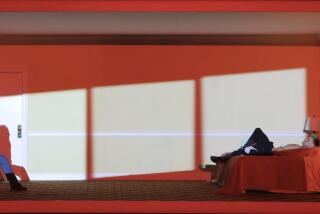O.C. MUSIC / RANDY LEWIS : Hail to the Chieftains : The Irish Sextet Taps Primal Emotions With Flair in ‘Christmas’ Program
- Share via
One traditional carol missing from the Chieftains’ “Christmas in Ireland” program Monday was “Joy to the World.” It might not have been an oversight. Given the way this uniquely gifted sextet approaches every aspect of its music-making, that particular selection would have restated the obvious.
The modus operandi of Ireland’s premier traditional music ensemble also was obvious: Play well and have fun. Any number of outfits can do one or the other, but it is the Chieftains’ rare ability to do both with a flair that has won them a fiercely loyal following, one that knows no musical boundaries.
Indeed, the sold-out concert--presented by the Orange County Philharmonic Society as part of an international music and dance series at the Orange County Performing Arts Center in Costa Mesa--successfully wedded the best of the folk and classical traditions. Beneath the virtuosic musicianship and symbiotic interplay were instantly hummable tunes that spoke directly to heart and soul.
A fine example was group leader Paddy Moloney’s excerpt from his score for the 1992 film “Far and Away.”
As throughout the two-hour performance, the group began the piece with a small contingent--in this case, Moloney’s tin whistle offering a bittersweet melody over the celestial accompaniment of Derek Bell’s Celtic harp.
Moloney played his $10 instrument as though it were worth a million. His haunting tune could have persuaded even the biggest cynic that the concert hall was a deserted hillside, and that each of the 3,000 listeners somehow had tapped into the spirit of an ancestral shepherd contemplating the meaning of solitary life in the still of a winter’s night.
*
Having completed the opening theme, Moloney switched to the uilleann (elbow) pipes and Bell summoned the sound of a massive pipe organ from his synthesizer’s memory. Fiddlers Sean Keane and Martin Fay, flutist Matt Molloy and bodhran drummer Kevin Conneff jumped in to flesh out the tune with wistful harmonies and vibrant counter-melodies.
This is the sort of versatility that invests a Chieftains performance with a seemingly endless series of tonal colors and textures. Like the early brand of New Orleans jazz that it well may have influenced, the music was cohesive enough structurally to keep the players functioning as a unit, yet loose enough to allow each band member the freedom to assert himself.
Molloy and Keane exhibited remarkable technique during solo spots but never at the expense of communication with the audience. Fay, less dazzling technically, was possibly the most evocative soloist of the evening with a heartbreaking rendition of the weep-in-your-Guinness ballad “Carrickfergus.”
Bell--who looks as though he should be hearing confession instead of performing on a concert stage--used one of his solo spots for an unlikely ragtime romp on the piano. It followed a harp outing that coyly saluted--or perhaps anticipated?--”I’m Called Little Buttercup,” the chestnut from “H.M.S. Pinafore.”
Conneff applied his liquid tenor to the haunting a cappella ballad “North America,” a perfect illustration of Moloney’s assertion that “folk music is the foundation of all music.” Its unadorned, unforgettable melody is a fraternal twin to “English Country Garden,” which composer Percy Grainger adapted in “Country Gardens,” his famous arrangement of the British folk song.
Still, the beauty of “simple” Celtic folk music--which the Chieftains play much as it was played decades, even centuries ago--is how powerfully it taps primal emotions, loneliness, grief, exaltation, love, the warmth of togetherness.
These reels and hornpipes virtually defy the problems of repetition that can plague other strains of folk music. A melody, usually four or eight bars, is introduced and then played again in a way that stirs a listener to re-experience its charm. Then comes another, and another, each as fresh as its predecessor.
The icing on the cake Monday was the dynamic traditional Irish dancing by four members of the Patricia Kennelly group from San Francisco. The women’s steps required ankles of rubber and legs of steel. The style places all its demands on the lower body--from the waist up, the dancers barely moved.
More to Read
The biggest entertainment stories
Get our big stories about Hollywood, film, television, music, arts, culture and more right in your inbox as soon as they publish.
You may occasionally receive promotional content from the Los Angeles Times.










